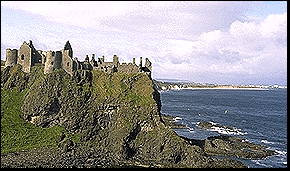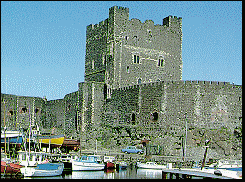 Dunluce
Castle
Dunluce
Castle
Original Official Site of the Northern Ireland Tourist Board
 This spectacular castlecrowned crag
on the famous north Antrim coast was shaped when the sea cut deep into
the land, exploiting cracks on either side of the rock.
This spectacular castlecrowned crag
on the famous north Antrim coast was shaped when the sea cut deep into
the land, exploiting cracks on either side of the rock.
The nomadic boatmen - Ireland's first inhabitants - who crossed from south-west Scotland in about 7,000 BC and left their flinty axes all along this rugged coast, must have seen the crag from the sea and may have ventured their flimsy coracles into the huge cave that runs through the rock to the land. You can still visit it by boat today.
The early Christians and the Vikings were drawn to this romantic place and an early Irish fort once stood here. For its crowning glory, however, the crag had to await the coming of those master-builders, the Normans. They had a habit of consolidating their victories by building castles, and they knew a good site when they saw one.
The battling MacDonnells ruled all this north-eastern corner of Ulster in the, late 16th century. Steeped in myth and legend and inhabited by giants, ghosts and banshees wailing through the sea mist, it has the most dramatic coastline in the British Isles, a veritable textbook illustrating the geological story of the earth. The ancient rocks stick out as brightly coloured cliffs along the edge of the plateau. There are red sandstones, white chalk, black basalt and blue clavs.
Richard de Burgh, Earl of Ulster, first built this castle at Dunluce. It often came under siege. In 1584 Sorley Boy MacDonnell captured it from the English when one of his men, employed in the castle, hauled his comrades up the cliff in a basket.
Sorley Boy came into some money in 1588 when the Spanish Armada treasure ship Girona was wrecked by storm off the Giant's Causeway. He used it to modernise the castle but he must have skimped on the kitchen, since in 1639 it fell into the sea and carried away the cooks and all their pots. Today the pretty blue flower of Dunluce' clusters round the castle's ruined shell and drifts of seapinks are the only sentinels.
 Carrickfergus Castle
Carrickfergus Castle
 Carrickfergus was a thriving town when Belfast was a sandbank.
When Henry II was king of England, the Norman John de Courcy had overthrown
the kings of the north of Ireland and established his rule from Carlingford
Lough up the east coast as far as Fair Head. In 1180 he built a massive
keep to guard the approach to Belfast Lough at Carrickfergus - the first
real Irish castle.
Carrickfergus was a thriving town when Belfast was a sandbank.
When Henry II was king of England, the Norman John de Courcy had overthrown
the kings of the north of Ireland and established his rule from Carlingford
Lough up the east coast as far as Fair Head. In 1180 he built a massive
keep to guard the approach to Belfast Lough at Carrickfergus - the first
real Irish castle.
In the early 17th century, Carrickfergus was the only place in the north where English was spoken; Gaelic was still the language of Ulster.
Exploring
County Antrim | Giant Causeway | The Castles
of Dunluce & Carickfergus |
The Glens of Antrim |
Northern Ireland Homepage | Travel Tips | Golf | Industrial Heritage | Walking, Hiking & Horseback | Activities | Calendar of Events | Transportation | Cuisine and Restaurants | Birdwatching | Fishing | Ancestral Heritage | County Antrim | County Armagh | City of Belfast | County Down | County Fermanagh | County Londonderry | County Tyrone | Tour Operators | InterKnowledge Home Page
Copyright (c) 1995-1997 interKnowledge Corp. All rights reserved.
